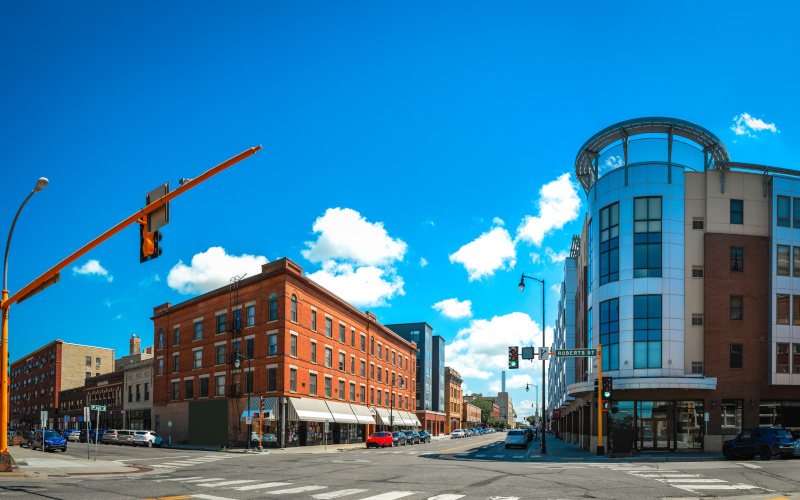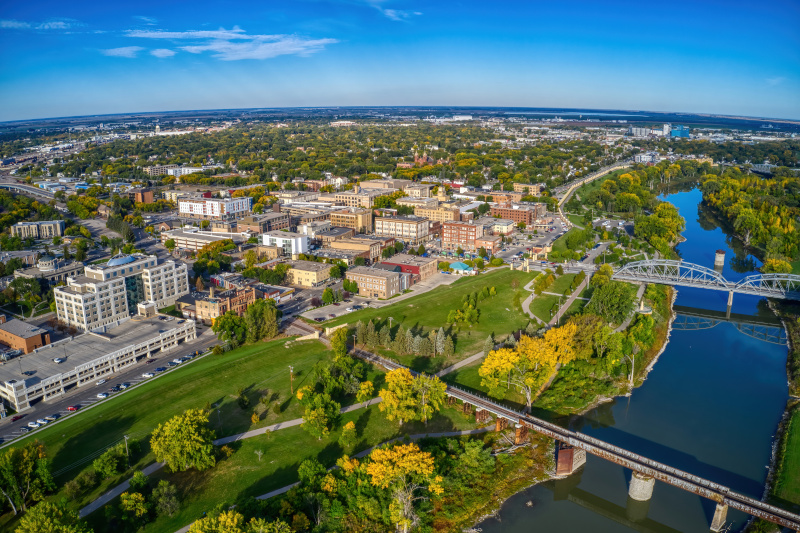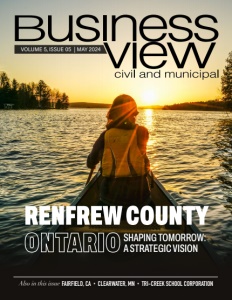North Dakota Department of Commerce
From fields to futures
Backed by rich natural resources and renewable energy, the North Dakota Department of Commerce has big plans for the future of the Flickertail State.
The state of North Dakota is known for its beauty. The outdoor landscape features vast plains adorned with golden wheat fields, punctuated by rolling hills, meandering rivers, and expansive prairies stretching to meet the big sky. And yet, despite the state’s 70,000 square miles of rugged land, it remains the most connected state in America.
How is that possible? It begins with the North Dakota Department of Commerce, which has actively invested in expanding its fiber optic infrastructure to improve broadband access across the state. This effort aims to connect rural communities and enhance internet speeds, reliability, and capacity for residents, businesses, and institutions.
Despite a population of under 800,000, North Dakota boasts one of the best employment rates in the country. The state’s oil industry has grown in recent years, pumping money into the economy. At the same time, renewable energy sources like wind power have boosted sustainability in the state and ultimately the entire country.
While the area faces its challenges, such as housing, for example, the North Dakota Department of Commerce envisions a bright future.
“Our economy has just exploded,” says Josh Teigen, the Commissioner of Commerce for the state of North Dakota.

Staying connected
Almost immediately, the COVID-19 pandemic yielded opportunities for North Dakota’s economy, beginning with the connectivity aspect.
“Most people don’t know North Dakota is the most connected state in the nation when it comes to fiber optic connectivity,” says Teigen. “So we were able to essentially take everyone in state government and most people in the private sector and move them into a digital format almost overnight because all of the infrastructure was already in place.”
North Dakota’s previous commitment to internet infrastructure meant it was prepared for the COVID-19 lock-in and allowed the state to be more connected than Vermont or New Hampshire, for example, two far smaller states.
The pandemic also revealed a global demand for two of North Dakota’s other key economic resources: energy and agriculture.
“Two-thirds of our economy is energy and agriculture,” explains Teigen. “And so those markets have been super, super strong. And so we’ve ultimately come out of the pandemic in a better financial position than when we went into it. I don’t know that anyone else can say that.”
North Dakota is now on pace to become the highest GDP per capita state in the nation by the end of 2024, estimates Teigen. The pandemic, as well as the Russia-Ukraine War, dramatically accelerated the state’s economic growth. There’s been unprecedented investment in North Dakota’s industries. Before COVID, there were about $2 billion worth of projects looking to relocate to the state. Today, Teigen estimates up to $70 billion worth of investments are looking to hit the ground in North Dakota.
That said, there are still some challenges to address. North Dakota is a highly rural state, so after a big event as the COVID pandemic hit, it has understandably taken a while for some of the workplace mechanisms to recover. Residents are still very sprawled, and Teigen hopes to clear that up shortly.
Optimizing workforce
North Dakota has the highest labor participation rate in the nation, says Teigen. With a population of around 788,000 people, there are roughly 40,000 open jobs.
“If every high school graduate in the state graduated, took a job, and didn’t go on to higher education, if everyone already in higher ed graduated, came out and took a job in the state, if everyone came off of unemployment and every person coming out of the correction system came out and took a job, we’d still have 20,000 open jobs in the state,” says Teigen.
But as a low-population state, North Dakota must attract new residents as this economic wave continues. Under Teigen’s watch, the state has established a widespread marketing campaign geared toward showing future residents the unknown prestige North Dakota has to offer. There’s now an online portal that matches people who are interested in moving to the state with job providers, community champions, and resources to facilitate that transition.
“We can tap in and say, ‘Hey, there are a lot of great jobs here.’ There’s a great quality of life. Here are all the resources they need to make that decision, and then kind of taking the concierge approach to getting them to land here,” says Teigen.
The post-COVID work-from-home culture has people prioritizing where they want to live and then determining what work they can do. That culture benefits North Dakota’s economy, as new residents could live in the state and benefit from lower taxes while working for a company in Silicon Valley, for example.
New residents, new houses
As the local economy booms and North Dakota’s workforce grows, an affordable housing crunch is inevitable. Teigen outlines a couple of elements to combat that problem, starting with the North Dakota Housing Finance Agency. This agency helps augment the housing market in certain areas by bringing more units online and making them more affordable.
The state also has the Bank of North Dakota, which Teigen calls his “secret weapon.” It’s the only state-owned bank in the nation, which originated over 100 years ago when local farmers were upset about how banks in Minneapolis were treating them. The Department of Commerce is currently considering how this $10-billion bank can help put North Dakota ahead of the competition in housing affordability, interest rates, buy-downs, increased lending, and solutions for appraisal gaps in rural areas.
The exact strategic science isn’t perfect yet, Teigen says, but he’s certain the state commerce team is weighing multiple solutions for 2024 as the state looks to accommodate home buyers.

Aerial View of Grand Forks, North Dakota in Autumn
Investments and partnerships
As Teigen points out, there are other states in the country uninterested in new business or actively outsourcing projects, such as Minnesota or California. North Dakota, however, is hungrier than ever.
Firstly, North Dakota has primacy with the Environmental Protection Agency (EPA) thanks to its air quality, water quality, and carbon sequestration permitting, among other elements. Engaging with a state is faster and more reliable than engaging with a federal government agency, Teigen says.
Overall, North Dakota has the natural resources (oil, gas, corn, soybeans, and 14 other crop varieties), a favorable tax landscape, and a regulatory environment that makes the state second to none for investment and development. So far, everyone is reaping those benefits.
“Right now we’re seeing capital just pouring through our borders like we never anticipated,” says Teigen.
Notable success stories include a company called Denbury, which produced the first carbon-negative barrel of oil. A different $5-billion gas-to-liquids project chose North Dakota as its landing spot over Alberta, Oklahoma, Texas, and Louisiana, and has since been an overwhelmingly positive project for the state.
The governor of North Dakota has also pledged that the state will become the first carbon-neutral state in America. The area’s unique geology allows scientists to harness all the carbon dioxide produced in North Dakota and store it for approximately 8,000 years. That unique element has prompted sustainability partnerships, including a hydrogen hub located in the state.
“We’re going to have this hydrogen – [the] production, transportation, and consumption of hydrogen lead the way from a sustainability standpoint,” says Teigen. “So a lot of really exciting things happening there.”
Infrastructure on tap for the future
As a massive producer of natural gas, North Dakota needs more transportation infrastructure to move its natural resources within the vast state and elsewhere in the country. There’s a pipeline proposal in the works, which figures to connect the state from west to east and better service local communities. That new pipeline will connect to another major system that can deliver natural gas to rural communities, but also make the resource available for large industrial developments.
The Missouri River, which carves through the state, is also a fantastic natural resource. With water growing scarcer by the day, there’s another project in the works to take water from Missouri and divert it east to major metropolitan areas where most of North Dakota’s agriculture development takes place.
“That’s where the state has invested a tremendous amount of money and kind of where we’re focused now,” says Teigen.
Beyond those hardcore infrastructure projects, the state is also tackling the goal of servicing 100% of the United States’ pig iron demand. Pig iron is a key element in the steelmaking process. Right now, Minnesota, for example, can’t produce pig iron due to the state’s regulatory environment. Once the project gets rolling this year, the goal is to dominate the domestic pig-iron market, offering a more reliable alternative to importing from other countries such as China, Russia, or Brazil.
Despite everything the state has achieved, North Dakota’s economic engine keeps turning. With a blank canvas of beautiful landscapes and industrial freedom, the Flickertail State is poised to be an economic powerhouse for years to come.
AT A GLANCE
North Dakota Department of Commerce
What: The economic office that ignites opportunity and empowers growth
Where: North Dakota, USA
Website: https://www.commerce.nd.gov/


